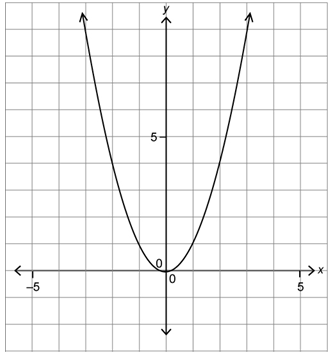Lesson 2: Relations
Explore 2
Domain and Range
In Lesson 1 you learned about independent and dependent variables. The set of all possible values of the independent variable in a relation is called the domain of the relation. These numbers would include those in the first column of a table, the first elements of a set of ordered pairs, and the x-coordinates of all points on a graph.
On the other hand, the set of all values of the dependent variable of a relation is called the range of the relation. These numbers include those in the second group of an arrow diagram, the second elements of a set of ordered pairs, and the y-coordinates of all points on a graph.
The domain and range are used to describe relations. Knowing the domain and range of a graph can help you to understand the limits of the relation. For example, you can know how high and how low a graph extends as well as how far left and right it extends. In some cases, a graph—such as a line—may extend infinitely in a particular direction. The domain or range can be used to describe this property.
The domain and range of a relation can be described in a number of different ways. These include the following:
-
list
-
words
-
number line
-
set notation
-
interval notation
Each of these different ways will be described in more detail.
List
The elements of the domain and range are listed. If an element of the domain or range appears more than once in the relation, the element is only listed once. It is typical to see the elements listed in ascending numerical order.
Ex 1
For the relation {(1, 4), (2, 12), (3, 20), (4, 28), (5, 36), (6, 44)}, the domain is (1, 2, 3, 4, 5, 6). The range is (4, 12, 20, 28, 36, 44).
Words
The domain and range are stated or written with words. Words are used when it is not efficient to list the elements.
Ex 2
The domain or range of a relation could be stated as “the set of all real numbers.” In other words, any real number is a possible value of the independent variable.
The domain or range of a relation could be expressed as “the set of all real numbers greater than ten.” In this case, only the real numbers greater than 10 are possible values of the dependent variable.
Number Line
You have used number lines in previous math courses to graph inequalities. You can also use number lines to report the domain and range of a relation.
Ex 3
To report the domain “the set of all real numbers greater than or equal to zero,” you could use the following number line.![]()
Similarly, to report the range as “the set of all numbers between 1 and 5, not including 1 and 5,” you could use the following number line.
![]()
Set Notation
Set notation is a formal way of stating the domain and range. In set notation, you give a generic name to the set of numbers. Usually a lowercase letter is used; x is a perennial favourite, but other letters are also used.
When using set notation, remember the following symbols:
-
such that: |
-
consists of, is an element of: ε
-
is less than: <
-
is greater than: >
-
is less than or equal to: ≤
-
is greater than or equal to: ≥
-
equals: =
Ex 4

Interval Notation
Interval notation is primarily used to express the domain or range consisting of all of the real numbers between two points. The use of different styles of brackets indicates whether those points are included or excluded from the domain or range. Note that infinity is not a known quantity, so we always use a round bracket next to it.
Ex 5
 Read
Read
Go to your textbook to read through some examples that demonstrate how the domain and range of a relation can be determined. Pay particular attention to when the use of a list to report domain and range is appropriate, and when it is not appropriate.
Foundations and Pre-calculus Mathematics 10 (Pearson)Read the following examples:
Note: You will see the use of the word function in your textbook. A function is a special type of relation. You can think of a function as a relation in these examples. You will learn more about functions in Lesson 3. |
 Self Check
Self Check
The following is the graph of a relation with equation y = x2. Express the domain and range of the graph.

 Watch and Listen
Watch and Listen
Watch 'Domain and Range of Relations' on a graph to practice finding domain and range. Note he writes his answers in set notation but is not careful about the formatting we like.
 Try This 15
Try This 15
Complete the following in your course folder ( binder), showing all work.
Go to your textbook now to practise applying the concepts that you have learned. Show work to support your answers. The work may be descriptive or mathematical.
TT 15. Complete “Exercises” questions 4, 7, 9, 19, and 21.b) on pages 294 to 297.
Use the link below to check your answers to Try This 15.
Possible Try This 15 (TT15) Solutions
Mathematics 10C Learn EveryWare © 2010 Alberta Education
